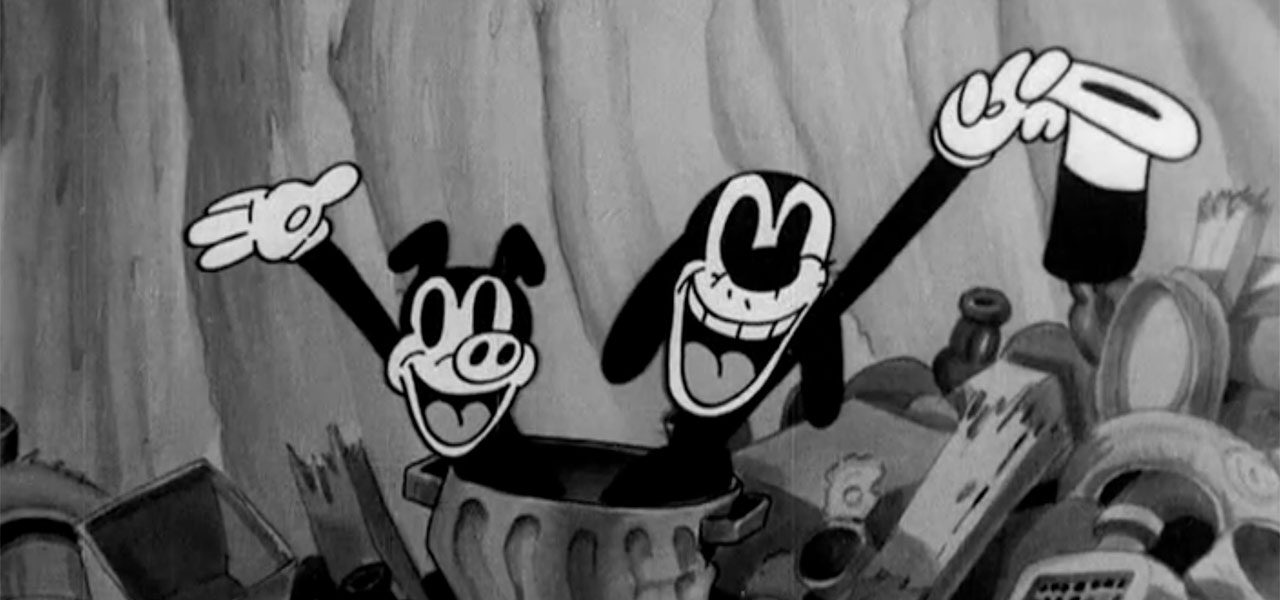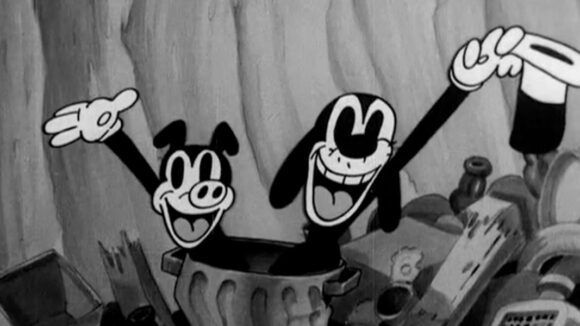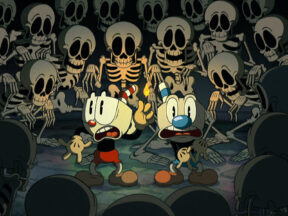

The Wild Classics Of Rubber Hose Animation That Inspired ‘The Cuphead Show!’
Netflix’s new animated series The Cuphead Show! (based on the hit video game Cuphead) boasts a visual style that draws on the classic rubber hose cartoons from the 1930s.
Rubber hose animation is a subject near and dear to my heart, so I’m ecstatic that it’s coming back into the limelight through a high-profile streaming series.
As far as I’m concerned, the surrealistic imagination of those early thirties shorts has never been topped. Today, we’re going to take a trip back in time – 90 years back, in fact – and rediscover the cartoons that inspired Netflix’s latest series.
To whet your appetite, we’ll begin with a prime example: the Betty Boop classic Snow White (1933), which was animated from beginning to end by Roland Crandall and features a killer soundtrack by jazz legend Cab Calloway. It’s overflowing with weird ideas and deliciously off-kilter visual fireworks.
— Cartoon Study (@CartoonStudy) February 22, 2022
For those who aren’t aware, rubber hose animation is the style seen in early sound cartoons where the characters’ bodies squash and stretch like they have no bones and their limbs flop around like noodles. Certain visual motifs, like pie-cut eyes, white gloves, and two-button pants, are associated with these cartoons, but their primary characteristic is bouncy elasticity, which is on overdrive in Betty Boop’s May Party (1933).
— Cartoon Study (@CartoonStudy) February 22, 2022
The man credited with inventing the rubber hose approach is Bill Nolan, who gave rounded flexibility to his animation in the silent Felix the Cat and Krazy Kat shorts. Look at how beautifully Nolan distorts the characters’ bodies in the Walter Lantz short Henpecked (1930).
— Cartoon Study (@CartoonStudy) February 22, 2022
The world of these cartoons is infectiously charming. Characters are constantly bobbing up and down to the beat and any prop or body part can be turned into a musical instrument at a moment’s notice. For instance, when original Looney Tunes star Bosko gets cornered by a gang of dangerous jungle animals in Congo Jazz (1930), he leads them in a peppy arrangement of “Giving It This and That.”
— Cartoon Study (@CartoonStudy) February 22, 2022
These cartoons aren’t hindered by dull concepts like realism and internal consistency. Inanimate objects frequently come alive and get involved in the action, as seen in the Max Fleischer short Barnacle Bill (1930), starring Bimbo.
— Cartoon Study (@CartoonStudy) February 22, 2022
Characters can also detach their limbs or heads for the sake of a sight gag, as demonstrated by Oswald the Lucky Rabbit in Broadway Folly (1930).
— Cartoon Study (@CartoonStudy) February 22, 2022
Crazy transformations show up all over the place in these shorts. The titular figure in Fleischer Studios’ Mysterious Mose (1930) repeatedly morphs into different characters up until the final “reveal” that makes no sense and explains nothing (which is, of course, why I love it).
— Cartoon Study (@CartoonStudy) February 22, 2022
You can also find lots of unusual character designs, particularly in cartoons involving monsters, aliens, and/or unidentifiable mutant creatures. There are some doozies in this print (owned by Mark Kausler) of the spooky Van Beuren cartoon The Wild Goose Chase (1933).
— Cartoon Study (@CartoonStudy) February 22, 2022
Rubber hose cartoons are famous for their macabre imagination. The brilliant and genuinely unsettling Fleischer short Swing You Sinners! (1930) is like a nightmare captured on film. That wild-eyed chicken scatting against a warping background is an unforgettable image.
— Cartoon Study (@CartoonStudy) February 22, 2022
The lively animation in these cartoons is inseparable from the swinging soundtracks. Gene Rodemich’s foot-stomping arrangement of “Mean Music” from the underrated Van Beuren short Pots and Pans (1932) is an incredible recording. I was floored when I first saw this cartoon on a public domain dvd as a kid, and I had to watch it over a million times.
— Cartoon Study (@CartoonStudy) February 22, 2022
The stories in these cartoons follow stream-of-consciousness dream logic, and end with nothing resolved and no lesson learned. The Fleischer cartoon Silly Scandals (1931) closes on complete psychedelic pandemonium (and no, there’s no context that explains this).
— Cartoon Study (@CartoonStudy) February 22, 2022
Every American studio was putting out fun cartoons in the rubber hose era; I don’t think you could write off any of them. The Walt Disney Studio led the charge away from rubber hose in the mid-1930s, as they developed more believable movement, but the early Mickey Mouse cartoons are loaded with cheerfully impossible gags, like this all-timer from The Plowboy (1929).
— Cartoon Study (@CartoonStudy) February 22, 2022
When Mickey Mouse co-creator Ub Iwerks left Disney to start his own studio, he made some delightfully eccentric cartoons starring characters like Flip the Frog and Willie Whopper. Iwerks’ films are the rowdiest shorts of the era, full of vulgar jokes, grungy Depression-era urban settings, and anti-authority humor. Traffic cops receive the brunt of Iwerks’ ire in these shorts, as you can see in this bit from The New Car (1931).
— Cartoon Study (@CartoonStudy) February 22, 2022
The early Warner Bros. cartoons – starring characters like Bosko and Foxy – are derivative of the Mickey Mouse shorts, only with jazzier soundtracks and a greater emphasis on guzzling booze (during Prohibition, no less). You Don’t Know What You’re Doin’ (1931), featuring short-lived cartoon star Piggy, is a masterpiece of beer-soaked hallucinations and red-hot music courtesy of Abe Lyman and his Orchestra. Orlando “Slim” Martin’s trombone licks are perfectly matched by the car’s drunken convulsions.
— Cartoon Study (@CartoonStudy) February 22, 2022
The most unhinged cartoons of the era are the Oswald the Lucky Rabbit cartoons at the Walter Lantz studio. While many 1930s shorts have a surreal sense of humor, the combination of loopy Bill Nolan animation and peculiar dialogue littered with non sequiturs gives these Oswalds an almost dadaist sense of audience-testing absurdity. The Phantom of the Opera parody Spooks (1930) is one of my all-time favorite cartoons because it’s so aggressively odd.
— Cartoon Study (@CartoonStudy) February 22, 2022
The oft-overlooked Columbia cartoons feature some of the best artwork of the 1930s, thanks to Dick Huemer’s highly appealing drawing style. The early appearances of the bulbous-headed Scrappy are different from other series in that they start off with relatable boyhood scenarios, like trying to keep your clothes clean or avoiding your pesky younger brother, before springboarding into cartoon abstraction, like an ancestor of Rocko’s Modern Life. Note that Scrappy doesn’t even take his Mickey Mouse gloves off to bathe in Sunday Clothes (1931).
— Cartoon Study (@CartoonStudy) February 22, 2022
The Van Beuren cartoons were produced on a low budget, but their crudeness only adds to their hypnotic weirdness. I adore these cartoons, which feature erratic narratives and oddball characters like the Little King and Tom & Jerry (not the cat and mouse). At times they resemble some kind of animated Outsider Art. Gypped in Egypt (1930), starring obscure characters Waffles & Don, is a high-water mark of unpredictable insanity.
— Cartoon Study (@CartoonStudy) February 22, 2022
The Terrytoons, which always seem to be populated by legions of mice and mechanical horses, are probably the most formulaic cartoons of the time, but they aren’t without their spurts of inspiration. The legendary Bill Tytla, who went on to animate Disney characters like Grumpy, Stromboli, and Dumbo, lends great exaggeration to this psychologically twisted monologue by the villain in Bluebeard’s Brother (1932).
— Cartoon Study (@CartoonStudy) February 22, 2022
Still, the rubber hose capital of the world was the Max Fleischer Studio in New York, which produced the gloriously bizarre Betty Boop cartoons (and later, the hilarious Popeye series). Supervising director Dave Fleischer had a theory in making cartoons that every shot should contain a gag, and he would have the animators come up with their own jokes as they went along (he would flip through their drawings and ask, “Where’s the gag?”). The constant stream of off-the-cuff comic business and ad libs gives these films a dreamlike atmosphere, and the soundtracks, which often feature guest musical acts like Cab Calloway, Louis Armstrong, and the Mills Brothers, have an authentic jazz flavor. I Heard (1933), directed by creative genius/WWII war hero Willard Bowsky and featuring music by Don Redman and his Orchestra, might break some kind of record for the most gags ever crammed into seven minutes.
— Cartoon Study (@CartoonStudy) February 22, 2022
Animators outside of the United States also got on board the rubber hose train. The excellent Japanese short Ugokie Kori no Tatehiki (1933), directed by Ikuo Oishi, plays like an Ub Iwerks cartoon with samurais. A few years later, Osamu Tezuka, known as the Godfather of Anime and the God of Manga, would draw inspiration from early Mickey Mouse and Betty Boop cartoons in his work, which led to the “large eyes” style we now associate with anime.
— Cartoon Study (@CartoonStudy) February 22, 2022
Rubber hose animation fell out of favor by the mid-1930s, but its influence can still be felt in modern cartoons. The use of the Hawaiian lap steel guitar in Betty Boop’s Bamboo Isle (1933) really calls attention to how much these black-and-white shorts have in common with the whimsical humor in Spongebob Squarepants.
— Cartoon Study (@CartoonStudy) February 22, 2022
My hope is that The Cuphead Show! encourages people to seek out these wonderful and strange old films, and also inspires new artists to play around with the endless possibilities of the medium. To go out on a high note, I present the climax of the Fleischer masterpiece Bimbo’s Initiation (1931), arguably the pinnacle of rubber hose animation, in which a gang of weirdos try to recruit Bimbo into their cult. The technical skill of the animation here is staggering (look at those moving perspective shots!), and that head-scratching ending never fails to make me laugh.
— Cartoon Study (@CartoonStudy) February 22, 2022
This concludes the latest column of Cartoon Study, a new feature by historian and animator Vincent Alexander, in which he explores animation from the past and documents how classical techniques inform and inspire contemporary animation practices. Future articles in the series will be available only to those who have signed up for a Cartoon Brew site account (it’s free and you can sign up by clicking on the CB circle on the right-hand side of page).

.png)
